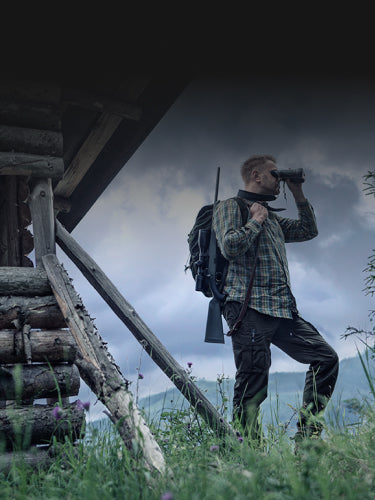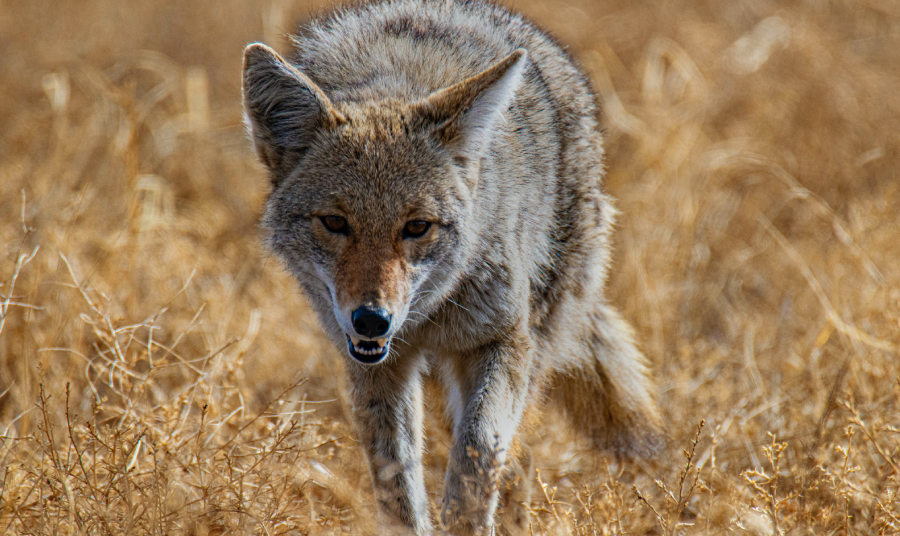Coyote hunting can be a challenging and rewarding experience for many hunters. Understanding the behavior, habitat, and physical characteristics of the coyote, scientifically known as Canis latrans, is crucial for successful hunting.
Coyotes are medium-sized canids with a dog-like appearance. They have pointed, yellowish ears, a slender, pointed muzzle, and a bushy, short tail with a black tip, housing an organ known as the violet gland. The violet gland secretes a musky oil with a distinct violet scent (hence its name), predominantly used by wild members of the canine species like wolves, foxes, and coyotes. Their coats vary in color, ranging from albino white to pale and tawny, with most individuals having a yellowish-gray hue, featuring whitish or buff throats and underparts. Coyote fur is coarse and heavy, with outer hairs tipped in black, creating a blended or grizzled appearance. Their coloration may differ based on their habitat, with desert-dwelling coyotes being lighter and more yellow, while those living at higher altitudes are grayer and blacker.
Social Structure and Behavior
Coyotes exhibit varied social structures, with some individuals moving in mated pairs, while others live in packs. Packs typically consist of a mated pair and their offspring, totaling three to seven members. Within the pack, there is a dominance hierarchy, and the alpha may be either male or female. Coyote packs have a territorial range of 5 to 25 square miles, which they defend from other coyotes. Boundary marking through urine and feces deposition is a common behavior observed in these animals.
A coyote’s diet is versatile and includes scavenging as well as hunting for small mammals like gophers and birds. Larger animals such as deer and sheep may also fall prey to coyotes, leading to conflicts and extermination campaigns. However, despite these efforts, coyote populations have proven resilient and continue to survive and expand.
Coyote Tracking and Identification
Identifying coyotes accurately is essential to avoid mistaken kills and to practice responsible hunting. The bouncing gait of coyotes sets them apart from domestic dogs. To confirm the target, it is crucial to observe the animal before shooting. This is especially important when using thermal imaging systems like monoculars or digital riflescopes since fur patterns cannot be distinguished when viewed through infrared.
Coyote tracks closely resemble those of dogs, featuring four toes with claws in front of a triangular heel pad. In adults, the larger front track measures 2 ¼ to 2 ¾ inches long, comparable to the prints of a similarly sized dog like a beagle. To distinguish between a coyote and a small dog, assess the stride length. A small dog's stride typically measures around ten to twelve inches, while a coyote's stride spans 14 to 16 inches. Unlike a coyote, a dog will veer off a trail to explore things that no wild animal would deem interesting, like various flowers and trees it hasn’t had the chance to smell within the confines of the city. A coyote, however, will maintain a consistent path towards its hunting grounds, but may stop at places like burrows of smaller mammals.

When tracking a coyote, it is important to do the following:
- Look for clear, individual tracks.
- Follow the trail to determine the track pattern and gather additional information.
- Utilize other clues from signs and knowledge of the animal's behavior.
One of the most telling signs of a coyote trail is the animal’s scat. Distinguishing coyote scats can be challenging, particularly in areas where both foxes and coyotes reside. Coyote scats are usually 2 to 5 inches long and ¾ inch or larger in diameter. A general rule is that scats with a diameter of ¾ inch or more probably belong to coyotes.

Coyote hunting is a captivating endeavor that requires understanding the anatomy, social structure, behavior, and tracking techniques specific to Canis latrans. Responsible hunting practices and accurate identification are essential to protect other wildlife and maintain the delicate balance of ecosystems. Armed with the knowledge provided in this article, hunters can embark on their coyote hunting journeys, respecting nature and the environment while enjoying the thrill of the chase.
If our products have helped you in any way, share your story with us! Accepted stories will receive a 20% discount code.
Frequently Asked Questions about Coyotes
Q: What is the physical appearance of a coyote?
A: Coyotes are medium-sized canids with yellowish ears, a slender muzzle, and a bushy tail with a black tip.
Q: How do coyotes behave in social structures?
A: Coyotes may live in mated pairs or packs, with a dominance hierarchy and territorial range.
Q: What is the diet of a coyote?
A: Coyotes have a versatile diet, including small mammals, birds, and larger animals like deer.
Q: How can you accurately identify a coyote?
A: Coyotes have a bouncing gait, distinct tracks with four toes, and a larger stride length compared to small dogs.
Q: Why is it important to understand coyotes for hunting?
A: Understanding coyotes helps avoid mistaken kills, practice responsible hunting, and contribute to conservation efforts.





